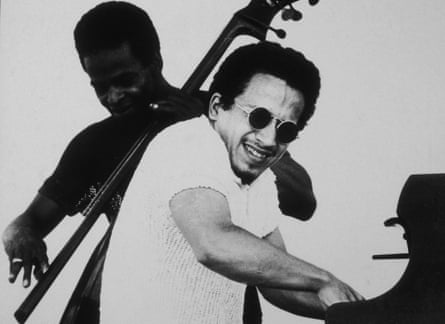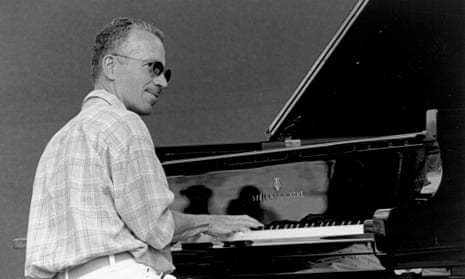Keith Jarrett was 70 on 8 May – so this is a good moment to come straight out and say, calmly and clearly, that he is not just the world’s greatest piano player but our greatest living musician. The jury will now explain its uncontentious verdict.
ECM is celebrating the birthday with the simultaneous release of two CDs: a recording of piano concertos by Samuel Barber and Bartók and a collection of solo improvisations from concerts in 2014. These represent two important aspects of Jarrett’s work but there is so much else. In the 1970s, he led two groundbreaking bands: the American quartet (with Charlie Haden, Paul Motian and Dewey Redman) and the more lyrical European quartet with Palle Danielsson, Jon Christensen and Jan Garbarek. From the 1980s onwards, his close collaborators have been drummer Jack DeJohnette and bassist Gary Peacock – the so-called Standards trio, though for me their versions of I Fall in Love Too Easily, or whatever, are less entrancing than what happens when they leave these much-loved, recognisable landmarks in their wake.
Celebrated as a pianist, Jarrett is actually a multi-instrumentalist. At the Deer Head Inn in the late 1960s, Stan Getz tapped him on the shoulder and asked if he would tour with him after Jarrett had finished a solo – on electric guitar. Eyes of the Heart, an underrated album from 1979, begins with an extended solo on soprano sax. On Spirits and No End, Jarrett plays every kind of percussion. But let’s stick, for a moment, with the two strands represented by the birthday releases: solo improvisations and classical piano.
Comparatively few jazz musicians have recorded classical music. Wynton Marsalis comes to mind, but the trumpet’s role in the classical repertoire is pretty marginal. The trumpet did not begin to achieve its expressive potential as a solo instrument until it found its way into the hands of Louis Armstrong. The piano, by contrast, is the centre of the western classical tradition. If critical bouncers at the door of the pantheon of classical pianists have been hesitant to admit Jarrett, that is partly because he has not dedicated himself to the canon with the single-mindedness it demands. While his recordings of The Well-Tempered Clavier are depersonalised to the point of austerity – “this music doesn’t need my help” – Jarrett always points out that Bach was an improviser. And Beethoven was never happier than when destroying would-be rivals in what the jazz lexicon would later term cutting contests. In some ways, then, Jarrett’s improvisatory genius brings him closer in spirit to these composers than a dutiful adherence to their scores. Compared with the major concert pianists, Jarrett has covered only a fraction of the repertoire. He has not recorded a Beethoven piano sonata. (Because Beethoven tests and taxes him in a way that Bach or Shostakovich did not?) No matter, there are so many recordings of Beethoven – but there is only one Köln Concert.

If, in the aftermath of some cosmic power outage, all of Schiff’s performances of Bach’s Preludes and Fugues were wiped from the record it would be a loss, but we’d still have versions by Gould, Angela Hewitt and others – including Jarrett. And even if we lost every recording of them, we would still have the scores: the foundational documents on which the faith is built. But if we lost Jarrett, we’d have lost the music that only he was capable of making – in the sense of composing and performing. The Köln Concert is the iconic occasion and example, but several of his later solo recordings are stronger, if less melodically seductive.
Jarrett’s gorgeous melodies are almost inseparable from his supple rhythmic power. Now, rhythm is a hotly contested field – think of McCoy Tyner, his devastating left hand – but Jarrett has a knack of unleashing rhythmic surges radically in excess of what he’s actually doing. A crucial element of the solo performances, this becomes even more pronounced in the trio setting – listen to the first two chords on Flying, Part 2 on Changes – where he, DeJohnette and Peacock bounce off each other to ecstatic effect. If it’s a slight shame that, in the last decades, Jarrett has not collaborated more widely, we can take heart from the way that his trio is infinitely flexible. They’re funky, they play calypso, they’ve even done ragtime (regrettably). They play free, they dance.
Jarrett’s consistent quality across the spectrum of styles is matched by his creative longevity. Clearly, Ornette Coleman’s contribution is more historically important. Even if Coleman had recorded nothing after 1960, his legacy would be secure. The flipside of this is that, in spite of multiple flurries of activity, much of what Coleman has done since then feels like a postscript. In terms of sustained but varied quality of output over time, no one can rival Miles Davis, with whom Jarrett and DeJohnette played in the early 1970s. But except for the hiatus beginning in 1996 when Jarrett was laid low by ME – the first tentative steps towards recovery are poignantly documented on The Melody at Night, With You (1999) – there have been no arid stretches.
Every year ECM releases stunning material from Jarrett’s immense back catalogue. There has never been a period when you would go to hear Jarrett play just because it was Jarrett, in the way that at various times you might have gone to hear Dylan (speaking of whom, check out Jarrett’s 1968 recording of My Back Pages). You would go knowing there was a good chance of hearing something unrepeatably momentous. (There was also a good chance of hearing him repeatedly harangue members of the audience who coughed or took pictures.) That promise remains unbroken even now, as Jarrett turns 70.
There’s a track on Belonging (1974) called The Windup, but some of my favourite passages occur during what might be called the wind-down, after the climactic moments. Actually, it’s often difficult to be sure exactly when the peak has been reached. The music is always capable of rousing itself again after repeated climaxes. (The unfortunately sexualised vocabulary that has crept in here does at least permit us to address the subject of Jarrett’s writhing and groaning. Sometimes the groans occur at moments of bliss. On other occasions it can seem not that he’s faking it, exactly, but that rather than being the unstoppable expression of rapture, the cries might be self-urging attempts to achieve a transcendence that has proved elusive.) Consider Somewhere/Everywhere from the 2013 album Somewhere. The trio start with the Bernstein show tune and then glide into the collective trance of a Jarrett original. It builds and builds and then, having achieved maximum intensity and complexity, begins its final descent around the 15-minute mark. But the best is still to come, in the remaining four minutes, which could happily have been extended to 14 or 40. We can be confident that there will be more wonderful moments to come in Jarrett’s eighth decade, in the (hopefully) long wind-down of his incredible career.
Geoff Dyer’s book about jazz, But Beautiful, is published by Canongate (£9.99). Click here to order a copy for £7.99
